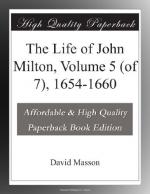Burnet’s account is that the whole country partook
of this growing prosperity, which he attributes to
the excellent police of the English, the trading they
introduced, and the money they put in circulation.
“A man may ride over all Scotland with a switch
in his hand and a hundred pounds in his pocket, which
he could not have done these five hundred years,”
was Mr. Samuel Desborough’s summary account
afterwards of the state of the country which he had
helped to administer under the Protectorate; and Cromwell’s
own reference to the subject is even more interesting
and precise. Acknowledging that the Scots had
suffered much, and were in fact “a very ruined
nation,” yet what had befallen them had introduced,
he hinted, a very desirable change in the constitution
of Scottish society. It had enfranchised and
encouraged the middle and lower classes. “The
meaner sort in Scotland,” he said, “love
us well, and are likely to come into as thriving a
condition as when they were under their own great
lords, who made them work for their living no better
than the peasants of France;” and “The
middle sort of people,” he added, “do
grow up there into such a substance as makes their
lives comfortable, if not better than they were before.”
Of course, in neither of these classes, any more than
from among the dispossessed nobles and lairds, can
the sentiment of Scottish nationality and the pain
of its abolition have been extinct. Yet one notices,
towards the end of 1656, a soothing even in that respect.
The Scots, all but universally, by that time, had acquired
the habit of speaking deferentially of “His
Highness” or “His Highness the Lord Protector”;
correspondence with Charles II. had entirely ceased;
the Edinburgh barristers had returned to the bar;
and the Scottish clergy, pretty generally, left off
praying for Charles publicly. Lord Broghill’s
admirable management had helped much to this reconciliation.
“If men of my Lord Broghill’s parts and
temper be long among us,” wrote Baillie, “they
will make the present Government more beloved than
some men wish. From our public praying for the
King Broghill’s courtesies, more than his threats,
brought off our leading men.” Baillie himself
had yielded that point at last.[1]
[Footnote 1: Baillie, III. 236-321 (including
letters to Spang, July 19, 1654, Dec. 31, 1655, and
Sept. 1, 1656); Burnet (ed. 1823), I. 104-105; Chambers’s
Domestic Annals of Scotland, II. 249; Carlyle, III.
342-3 (Cromwell’s Speech XVII.).]
Raging yet among the Scottish clergy, and dividing
the Scottish community so far as the clergy had influence,
was the controversy between the Resolutioners
and the Remonstrants or Protesters (Vol.
IV. pp. 201-214, 281-284, 288-289, and 361).
By a law of political life, every community, at every
time, must have some polarizing controversy;
and this was Scotland’s through the whole period
of her absorption in the English Commonwealth and
Protectorate. The Protesters were the Whigs, and




